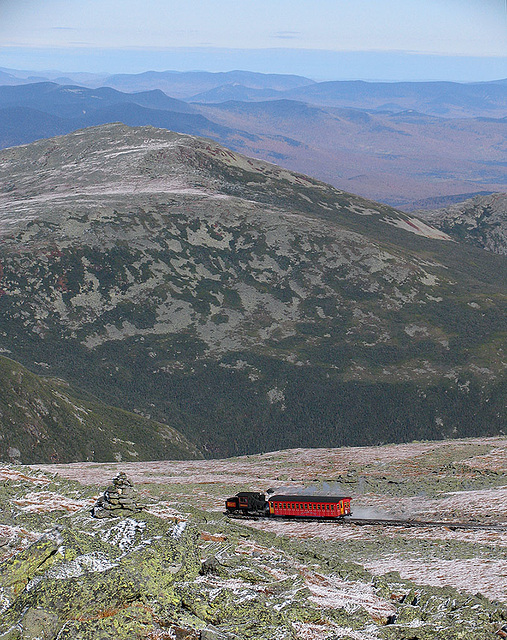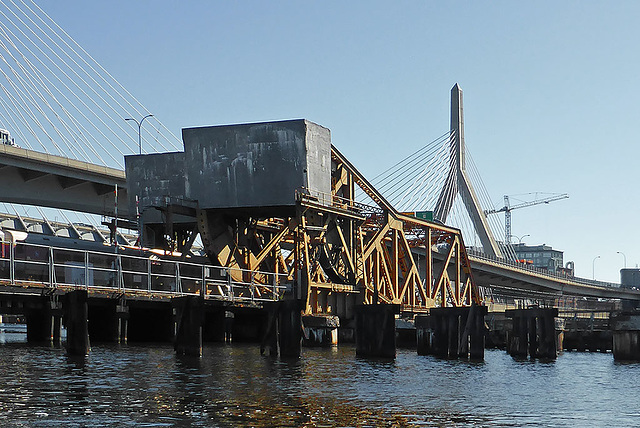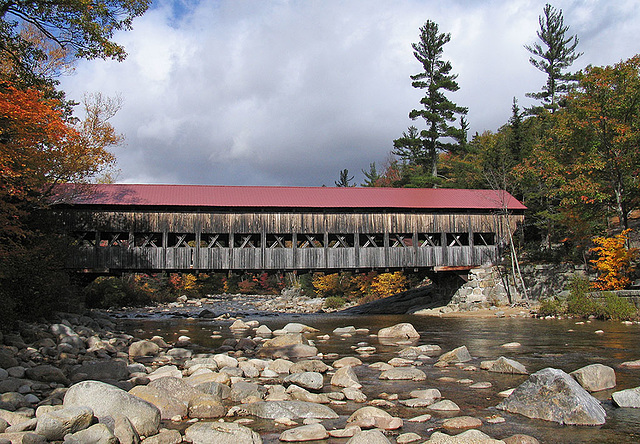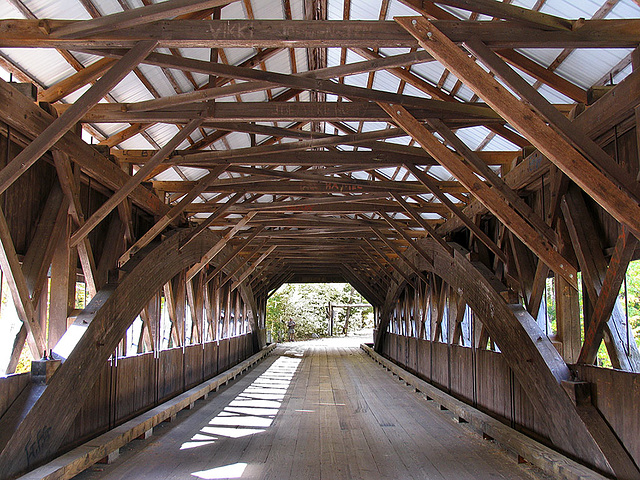
USA
Climbing Mount Washington
On a rare clear day locomotive No.2 'Ammonoosuc' and its coach are close to the summit of the Mount Washington Cog Railway. This is currently the oldest locomotive operating on this line, having been built in 1875 at the Manchester Locomotive Works and subsequently rebuilt after the major fire of 1895. That may well be Canada in the distance.
Charles River Bridges
These Scherzer rolling bridges carry the MBTA Commuter Rail over the Charles River in Boston. Originally this was the site of a bascule drawbridge for the Boston and Lowell Railroad, built 1835. It was the first movable railroad bridge in the United States.
In 1931 the Charles River bridges were replaced after extensive filling and dredging meant that the channel of the Charles River was relocated further away from North Station to allow the terminal tracks to converge into eight main leads crossing the river. The four new structures were double-track, single-leaf rolling bascule bridges. All four were nearly identical in design, varying only in their length and the degree of their skew, two spans crossing the channel at a slightly greater skew than the others. Two were 87 feet in length and two, 97 feet. Each span carried a single 629-ton overhead concrete counterweight and, operated by two electric motors, was controlled from the second floor of the new signal and interlocking station, located nearby on the north side of the river. The bridges were designed by Keller & Harrington, Chicago, while the steelwork was fabricated and erected by the Phoenix Bridge Company, Phoenixville, Pennsylvania. Today, only these two spans remain.
Crawford Notch
Autumn in New Hampshire as the lunch train on the Conway Scenic Railroad begins its descent from the summit at Crawford Notch back to North Conway.
Albany Bridge
The first bridge over the Swift River on this site was constructed in 1857 and destroyed by a windstorm in 1858. It was replaced with this roofed structure in 1858 at a cost of $1,300 minus the amount previously paid for the original bridge. The bridge has wide shallow arches and sharply raked facades and the beams are in the form of Paddleford trusses. The U.S. Forest Service replaced the wooden floor timbers with steel in 1981-1982. It is 120ft long with a clear span of 100ft and has a weight restriction of 6 tons.
John Hancock Tower
200 Clarendon in Boston was previously known as the John Hancock Tower and colloquially known as The Hancock. It has been the tallest building in Boston for more than 30 years, and is also the tallest building in New England. The building is a 60-storey, 790-foot (240 m) skyscraper, designed by Henry N. Cobb of the firm I. M. Pei & Partners and was completed in 1976. The highly reflective window glass is tinted slightly blue, which results in the tower having only a slight contrast with the sky on a clear day.
Engine 6
The fire house for Engine 6 is at 49 Beekman Street in New York. Being close to the World Trade Centre and being fitted with a high power pump to reach up 100 floors, the engine was one of the first to respond to the 9/11 attacks. Only one of the five men on duty that morning survived the collapse of the North Tower. The engine was also destroyed - the remains are now displayed at The New York State Museum in Albany as part of a permanent tribute to all those who lost their lives at the WTC on that day.
Inside the bridge
The first bridge over the Swift River on this site was constructed in 1857 and destroyed by a windstorm in 1858. It was replaced with this roofed structure in 1858 at a cost of $1,300 minus the amount previously paid for the original bridge. The bridge has wide shallow arches and sharply raked facades and the beams are in the form of Paddleford trusses. The U.S. Forest Service replaced the wooden floor timbers with steel in 1981-1982. It is 120ft long with a clear span of 100ft and has a weight restriction of 6 tons.
Sarah Mildred Long Bridge
The Sarah Mildred Long Bridge is a lift bridge that carries the US 1 Bypass over the Piscataqua River between Portsmouth, New Hampshire and Kittery, Maine. The bridge is a double deck truss bridge, with the US 1 Bypass road deck above and a railroad bed below.
The bridge features two separate movable spans. While the main lift span and its towers are the obvious primary moving feature, the second moving span is only apparent to water and rail traffic. On the north side of the bridge, the first non-trussed section of rail bed lifts up and moves south as a retractable bridge, coming to rest on top of the rail tracks inside the truss. This creates a waterway large enough for most recreational boats to pass through without the need for interruption of automobile traffic on the bridge. Completed in 1940, the bridge is the second to carry motor vehicle traffic between Maine and New Hampshire at Portsmouth, and replaced a river crossing dating from 1822.
A replacement bridge is now being constructed as a joint venture of Hardesty & Hanover and Figg Engineering. It will be higher than the current bridge, allowing for more ship traffic to pass underneath without opening the bridge. It will have 11 fewer piers in the river, as well as an improved collision system in the event of a ship impacting it.
The Piscataqua River Bridge in the background carries Interstate 95 and was completed in 1971.
End of season
Late afternoon sunshine on a deserted beach at Echo Lake State Park.
Jump to top
RSS feed- Latest items - Subscribe to the latest items added to this album
- ipernity © 2007-2024
- Help & Contact
|
Club news
|
About ipernity
|
History |
ipernity Club & Prices |
Guide of good conduct
Donate | Group guidelines | Privacy policy | Terms of use | Statutes | In memoria -
Facebook
Twitter










